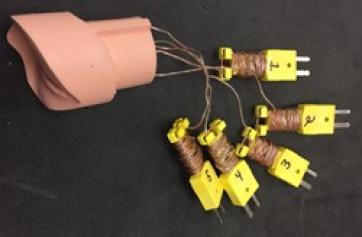INTRODUCTION
Non-lethal weapons provide operating forces the needed capabilities to clear personnel, control group movements, target selected individuals, and secure areas without destroying them. The U.S. Department of Defense (DoD) Directive 3000.03E, Policy for Non-Lethal Weapons, dated 27 September 2017, defines NLW as “…explicitly designed and primarily employed to incapacitate targeted personnel or materiel immediately, while minimizing fatalities, permanent injury to personnel, and undesired damage to property in the target area or environment” [1]. In addition, federal and local law enforcement personnel have used NLW since the early 1980s, with the primary goal to prevent or reduce the loss of life and limit the damage done to property. Some of the fielded NLW are shown in Figure 1.
![Figure 1: Currently Fielded NLW: (a) Acoustic Hailing Device, (b) Green Laser Interdiction System Gun, (c) Taser X26, (d) 12-Gauge Munitions, (e) M-84 Flash Bang Grenade, (f) Modular Crowd Control Munition (Source: Joint Non-Lethal Weapons Program [JNLWP] [2], U.S. Marine Corps., and Program-Executive Office Soldier).](/wp-content/uploads/2019/11/dsiacjournal_winter2019_nlwsurrogate_sedberry_banner_figure_1-719x360.jpg)
To explore the effects of NLW on human targets, one must first identify the stimuli, its mechanics, and the intended effects. Table 1 shows an example list of NLW stimuli and corresponding metrics for experimental data collection. Reversibility is a key tenet of NLW, and risk of significant injury (RSI) is the metric used to quantify reversibility of human collateral effects [3]. NLW must carefully balance effectiveness with potential injury risk. Figure 2 shows that traditional weapons have a threshold, or dose, that when crossed, measures the effectiveness of the weapon. NLW are bound on both sides by effectiveness and risk of injury [3].
Table 1. NLW Stimuli and Corresponding Experimental Metrics
RSI, a critically important system attribute for an NLW, is made up of at least two probabilities—the probability of a given dose and the probability that the dose will cause a significant injury. The probability of delivering a given dose may depend on the hardware, software, and environmental factors. NLW developers must identify the necessary dose to achieve the desired effect while remaining within the bounds of acceptable injury risk. For NLW, effectiveness and injury potential are frequently the constraints bounding the developmental trade space. Characterizing these two aspects is critical to NLW development and testing. Additionally, operating conditions often influence the dose of the stimuli on the target. Measuring the dose of the stimuli in a realistic environment is often an important aspect of NLW development and testing.
The JNLWP in the DoD has developed software and computer models that predict the risk of significant injury to human targets of these stimuli. The Human Effects Modeling Analysis Program (HEMAP) within the JNLWP’s Human Effects Office has developed a collection of detailed models that provides predictions for a range of human effects and permits a standardized and centralized approach for NLW human effects assessments. HEMAP software includes the capability to assess injury potential from blunt trauma, thermal injury, blasts and acoustic stimuli, and the visual effects of broadband optical stimuli. Other effects include radio frequency (RF)-directed energy, thermal laser effects, electromuscular (EM) disruption, underwater acoustic effects, mild traumatic brain injury (TBI), and behavioral response effects.
The JNLWP has developed software and computer models that predict the risk of significant injury to human targets of these stimuli.
Modeling allows developers to evaluate the effectiveness against the risk of significant injury of an NLW. As part of that process, researchers need to validate, verify, and accredit the various implemented models. For this purpose, the DoD and the NLW community need a common method to gather experimental input data that can be used for comparison to those models, gain meaningful human response data from NLW exposures, and obtain a testing platform with realistic and relevant human features which can gather multiple NLW exposures concurrently. The human-like features of the testing surrogate are essential to accurately represent certain exposure levels. Additionally, mechanical surrogate models are fast running, in complex operational scenarios, and can be used to assess effects of clothing and other artifacts.
The automotive industry has developed many human surrogate dummies for crash test purposes. Those dummies are calibrated for whole body acceleration and low-velocity, high-mass collisions. Whereas for NLW, blunt impact mechanical response needs to be assessed under conditions relevant to high-velocity, low-mass conditions. Previous NLW surrogates or manikins have focused on one or two areas of interest, such as blast and temperature or acoustics only. Numerous examples have been developed over the years. A manikin for assessing blast incapacitation and lethality was an anthomorphic test device used to assess blast threats, especially in air-containing organs [5]. Characterizing potential blast effects is a critical component in the human effects processes for RSI analysis. Johns Hopkins University/Applied Physics Laboratory (JHU/APL) developed the human surrogate torso model for nonpenetrating ballistic impact [6]. In addition, a human surrogate head model for blast TBI was developed by JHU/APL [7] and demonstrated during live fire blast experiments [8]. Other head phantoms have been created for measuring RF heating inside the head due to magnetic resonance imaging EM equipment [9]. There are numerous acoustic manikins, such as KEMAR and the Bruel and Kjaer 4128 head and torso simulator.
The NLW research and acquisition communities may be best served with a collection of various types of models to meet the variety of needs. Blunt impact injury, for example, may require computation models that are easy to propagate and can quickly assess sensitivity to material property values and projectile ballistic changes, in addition to a high-fidelity test surrogate capable of measuring the various exposures and validating the computational models. This dynamic back and forth between mechanical and computational models provides researchers and developers with an opportunity to characterize and influence the design trade space. Modularity of the surrogate is important for NLW considerations due to the wide variety of stimuli evaluated. Various combinations may need to be tested simultaneously. Further, instrumentation not needed for a given test can be temporarily removed to prevent damage.
To address the needs of the NLW community, a modular human test surrogate was developed that can produce human response data to a wide variety of NLW using a combination of commercial off-the-shelf (COTS) and custom sensor platforms (Figure 3). This modular human surrogate can be paired with a portable data collection system placed in a testing environment and monitored remotely, as needed. At present, two prototypes of the NLW testing surrogate have been delivered to the JNLWP at Marine Corps Base Quantico, VA.
![Figure 3: Modular NLW Surrogate With Sensors and Data Collection Equipment (Source: CFD Research Corporation [CFDRC]).](/wp-content/uploads/2019/11/dsiacjournal_winter2019_nlwsurrogate_sedberry_fig3.jpg)
The modular NLW human surrogate consists of the following parts:
- Anatomical head complete with removable eyes and ears and a rear access panel,
- Neck attachments for fixed or flexible neck interfacing,
- Two torsos using the same form factor—one for blunt impact and one for EM weapon evaluations, and
- COTS and custom sensors and data collection equipment.
ANATOMICAL HEAD
The anatomical head was designed after the 50th percentile male geometry and heavily modified to become modular in nature. For example, the eyes and ears were made modular for easy removal or exchange. This is key to replacing a broken sensor or, more importantly, changing the eye or ear sensor hardware for a different testing need. The anatomical head is composed of an outer layer of silicone material representing the skin on a human head. The inner layer of the anatomical head, the skull piece, is made of a harder polyurethane material. Both layers are secured after being produced from molds, improving the integrity and ruggedness of the finalized head for the surrogate. An access panel was designed into the modular NLW human surrogate to allow access to instrumentation before, during, and after testing and to ease switching out sensors based on need. Figure 4 shows the anatomical head.

REMOVABLE EYES AND EARS
The eyes and ears are made from the same silicone materials as the outer skin of the anatomical head. Design features were created inside the skull, allowing the ears and eyes to be secured to the head. The modular ears allow two configurations—one with acoustic or pressure sensors mounted at the tympanic membrane area and one for sensors mounted at the entrance to the ear canal. In acoustic testing and characterization, it is important to include the anatomical ear canal, as it acts as a natural amplifier.
FIXED AND FLEXIBLE NECK
The modular NLW surrogate supports a fixed or flexible neck, depending on whether head movement/acceleration needs to be measured. For example, using a laser-dazzling NLW does not require measuring head movement, so a fixed neck would be ideal for that testing. For a flashbang grenade with pressure, light, and sound components, the head movement in response to the pressure component needs a flexible (and realistic) neck. The modular surrogate supports a flexible Hybrid III neck using a 6 degrees of freedom (6DOF) or other sensor suite to measure head movement. The two neck configurations integrated with the anatomical head using the custom neck attachment are shown in Figure 5.
TORSO CONFIGURATIONS
The modular NLW surrogate currently utilizes two torso configurations aimed at different NLW testing and evaluation needs (shown in Figure 6). The first embodiment was developed as a modular torso capable of switching out pressure sensors and accelerometers to measure the blunt impact forces on the front of the chest. This configuration has an array of sensors suspended in a blend of materials that can be changed based on testing focus. For example, if higher blunt impact loadings are expected, the sensor suite can be easily switched but still utilize the same form factor. This is important for correlations and future NLW testing needs. The outer layer of this torso has a realistic skin-type material.
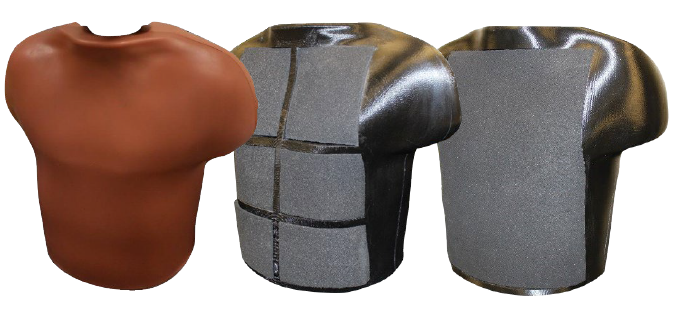
The second torso is designed for evaluating EM-type NLW. This torso has the same form factor as the first torso because it is important to maintain consistency across the geometries of the NLW surrogate. The current iteration of the EM torso uses an acrylonitrile butadiene styrene three-dimensional printed back and partial front structure. The front of the torso has a modular and removable single or multipad design with a conductive foam outer layer. EM NLW such as a Taser use barbs that discharge a voltage which incapacitates a human target. The EM torso on the NLW surrogate has roughly the same resistance as the human body (600 ohm) and can return important metrics such as peak voltage, net charge, pulse repetition rate, pulse duration, etc. Future iterations of this torso could utilize realistic skin-type materials.
One important advantage in using a realistic and anatomical torso is the ability to outfit the torso with articles of clothing or other protective equipment, if desired. For example, a Taser weapon fired into a torso with a heavy jacket might penetrate differently than into a torso test article with no clothing. The flexibility of this modular NLW surrogate gives NLW manufacturers and designers the ability to evaluate how their weapons will function against a realistic target.
SENSOR SELECTION AND INTEGRATION
The goal for each sensor solution was to use as many COTS sensors as possible to avoid longer and more difficult integration for data collection.
Pressure and Sound
COTS pressure transducers in two configurations (tube and pancake) were selected with a 50-psi range because most NLW do not approach this upper threshold. The pressure transducers can be mounted in the eye and at the ear for data collection (Figure 7). For sound, a piezoelectric microphone was selected with an upper end threshold of 190+ dB. Microphones were placed inside ear at tympanic membrane or outside the ear flush with skin.
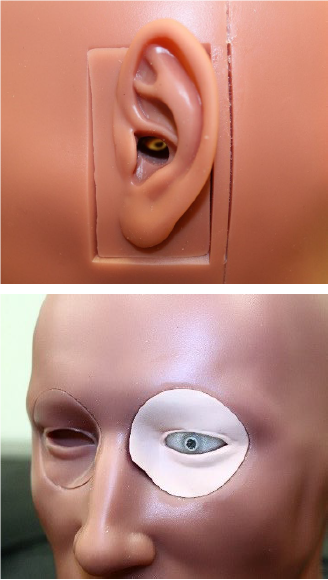
Light
The light sensor was developed in conjunction with JHU/APL. COTS components containing a photodiode, shutter, and optical cable were mounted inside the removable eye, which routed to a control box (Figure 8). This system functions much like the human eye, where the shutter response can be adjusted based on the type of environment the human surrogate is placed in (light/dark/etc.). As the eye is exposed to broadband or laser light, the shutter closes, mimicking the human eye response. The light exposure data is captured on a separate power meter.
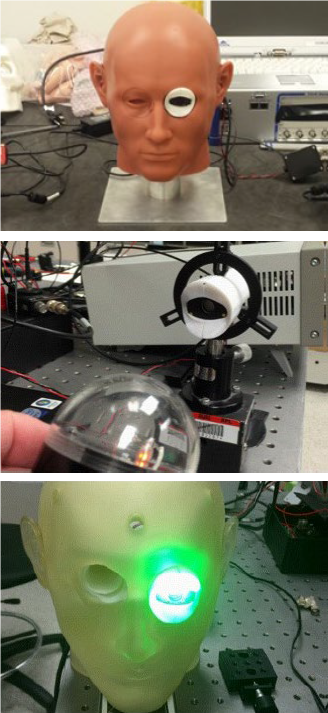
Temperature
One of the removable eyes was embedded with thermocouples in an array format to capture heating (Figure 9). The thermocouples were placed roughly 3 mm deep in the eye.
Blunt Impact
Two areas of importance for blunt impact are the head and the torso. The head of the modular NLW surrogate is outfitted with a 6DOF sensor placed at the top of the neck. This sensor measures linear and angular movement and loadings using a flexible neck (see Figure 5). A modular blunt impact torso was developed in conjunction with APL. The blunt torso uses an array of pressure sensors embedded in a soft tissue simulant and an accelerometer placed on the sternum of the torso. The array of sensors can be changed based on any specific location of interest on the front of the chest (Figure 6).
EM Torso
The EM torso was designed in two configurations. Initially, the design used a six-pad approach, which evolved into a singular-pad approach (see Figure 6). Each configuration functions the same, with the singular pad being slightly easier to replace after repeated uses. Each pad uses a conductive foam outer layer, which transmits the voltage data through the custom electronics to the rear of the torso where the electronics box and output cable connectors are located. The overall resistance of the system is like the human body (approximately 600 ohm), with step-down resistors to ensure the voltage sampled is at a safe level for the data acquisition system.
USE CASE TESTING AND EVALUATION
To date, the modular NLW surrogate has been verified to collect and produce the desired information and metrics for each NLW modality listed in Table 1. While many NLW were not available for testing, the individual stimuli (green laser, sound, etc.) of these weapons were tested in a benchtop and controlled evaluation area.
The NLW torso in the EM configuration was evaluated using a M26 Taser weapon system. A demonstration with a t-shirt over the torso was conducted for the JNLWP at Marine Corps Base Quantico. In that evaluation, a Marine Corps captain proficient with the weapon discharged two cartridges into the torso in front of JNLWP personnel to show the torso’s function. Images from that evaluation are shown in Figure 10.
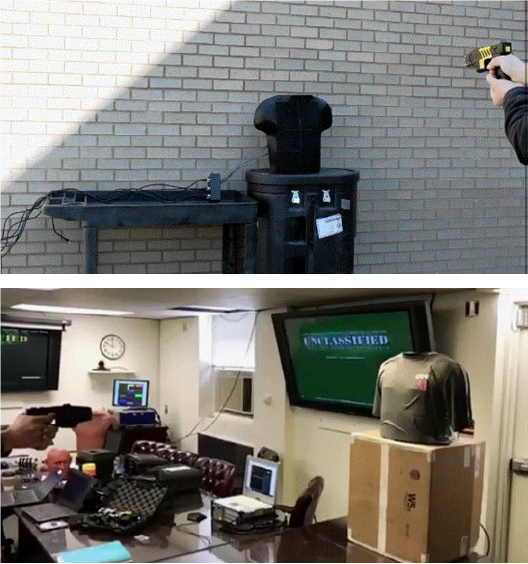
To verify that the torso was collecting reliable data, the metrics from the tests were compared to published data from a Taser on the M26 weapon. The results from this comparison showed very good agreement in all metrics. The differences were likely from newer or different supply batteries in the M26. The comparison data is shown in Table 2.
Table 2: Comparison Between Data Measured From the Test Surrogate and NLW System

The ocular sensor system was evaluated using two commercially-available, laser-protective sets of eyewear against a commercially-available laser pointer. The testing setup is shown in Figure 11, along with some of the results (Table 3). The testing results showed that both sets of laser eyewear had similar performance for this exposure.
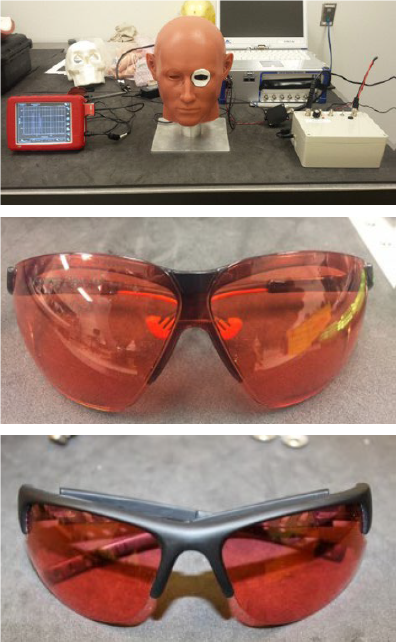
Table 3: Comparative Test Results of Ocular Sensor System

Finally, a use case test was conducted where multiple sensors captured data concurrently, as might be necessary in collecting data from an NLW such as a flashbang. These types of NLW output broadband light, loud sound, and blast overpressure. As no access to a flashbang was available, a pyrotechnic commonly used for entertainment and outputs similar to stimuli effects was used. The NLW surrogate head was outfitted with the eye sensor, pressure sensor in the eye and one ear, and a sound sensor in the opposite ear. All sensors were sampled at the same time during the test. The testing setup and a photo during the test are shown in Figure 12. Results are shown in Table 4. All sensors and data collection functioned within expected ranges.

Table 4: Results of Surrogate Flashbang Test for Pressure and Sound Exposure

CONCLUSIONS
An NLW human surrogate mechanical model and testing methodology has been shown to have the ability to capture data from a variety of NLW and NLW-like stimuli. The high-fidelity, anthropomorphic, and modular human form factor will aid the NLW community by having one common testing standard to allow correlation, comparison, validation, and data sharing. The modular NLW surrogate described here can be outfitted with COTS and custom sensors for injury areas of interest such as the ears, eyes, face, head, neck, and torso. As future needs arise, new sensors and sensor packages can be integrated into the NLW human surrogate, making this surrogate highly adaptable to the many different possible stimuli and operational scenarios.
Acknowledgments:
The authors would like to thank the following individuals for their contributions to this work: Dave Law (JNLWD); Dale Clemons, Vanessa Alphonse, and Paul Schuster (JHU/APL).
References:
- National Security Research, Inc. “Department of Defense Non-Lethal Weapons and Equipment Review,” July 2002.
- U.S. Department of Defense. “Current Non-Lethal Weapons.” Joint Non-Lethal Weapons Program, https://jnlwp.defense.gov/Current-Non-Lethal-Weapons/, accessed 26 October 2018.
- DoD Instruction 3200.19. “Non-Lethal Weapons (NLW) Human Effects Characterization,” 17 May 2012.
- U.S. Department of Defense. “Joint Non-Lethal Weapons Program Science & Technology 2016–2025 Strategic Plan.” Joint Non-Lethal Weapons Program, http://www. dtic.mil/ dtic/tr/fulltext/u2/1006419.pdf, accessed 26 October 2018.
- Anctil, B., M. Wonnacott, and D. Sullivan. “Preliminary Study of the Effects of Combat Helmet on Head/Neck Response under Rear/Side Impacts.” Defence Research & Development Canada, Valcartier, Quebec, 2009.
- Roberts, et al. “Computational and Experimental Models of the Human Torso for Non-Penetrating Ballistic Impact.” Journal of Biomechanics, vol. 40, pp. 125–136, 2007.
- Merkle, A. C., et al. “Development of a Human Head Physical Surrogate Model for Investigating Blast Injury.” IMECE2009-11807, pp. 91–93, 2009.
- Merkle, A. C., et al. “Human Surrogate Head Response to Dynamic Overpressure Loading in Protected and Unprotected Conditions.” SBEC 2010, IFMBE Proceedings 32, pp. 22–25, 2010.
- Kangarlu, A., et al. “Effects of Coil Dimensions and Field Polarization on RF Heating Inside a Head Phantom.” Magnetic Resonance Imaging, vol. 23, pp. 53–60, 2005.


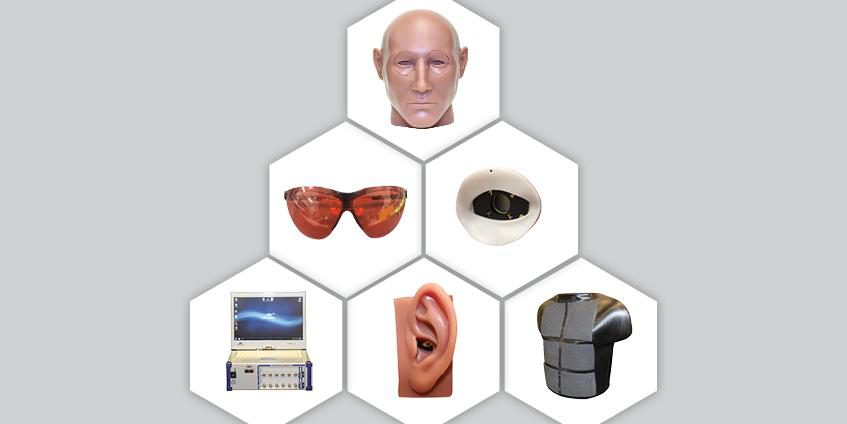
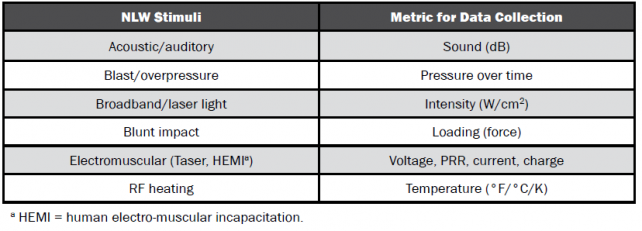
![Figure 2: Traditional Weapons (Left) vs. NLW (Right) (Source: JNLWP [4]).](/wp-content/uploads/2019/11/dsiacjournal_winter2019_nlwsurrogate_sedberry_fig2-753x408.jpg)
